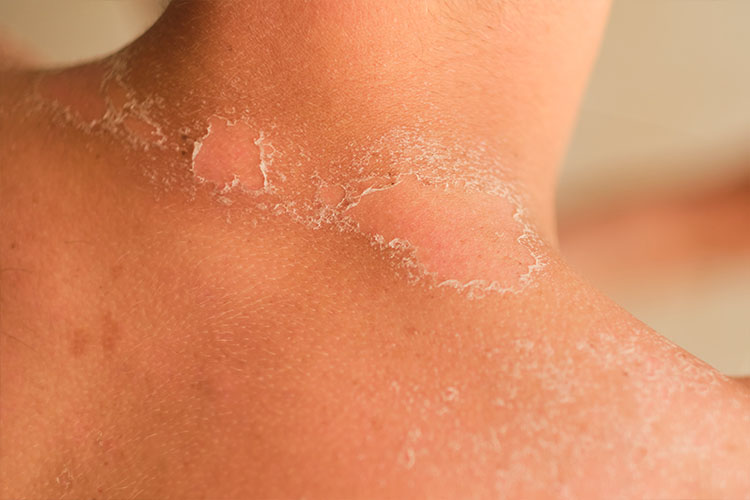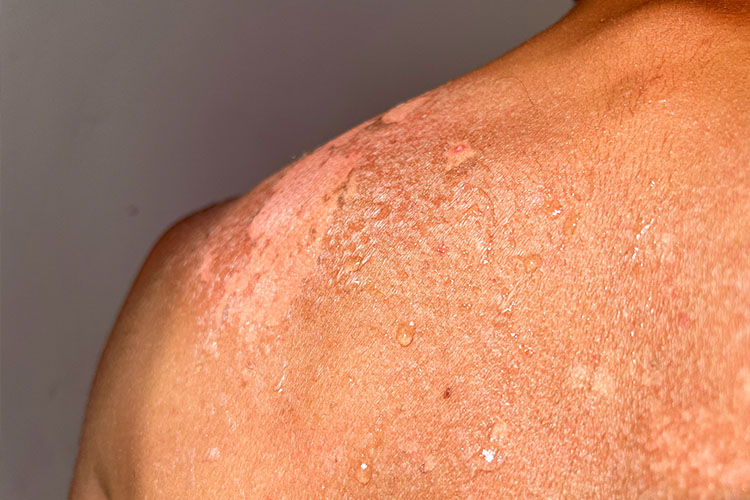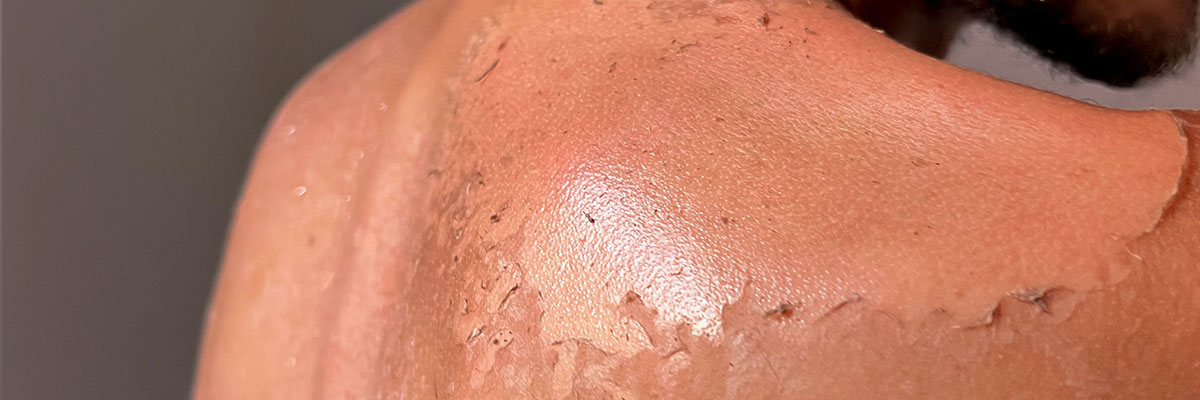Summary
Sunburn, or the burning of the skin caused by prolonged sun exposure, is a straightforward condition that many can relate to. It occurs when the outer layer of the skin is damaged by ultraviolet (UV) radiation from the sun, typically after spending extended periods outdoors without adequate protection. This condition is particularly common and noticeable during summer when people are more likely to engage in outdoor activities.
Sunburn develops when UV rays penetrate the skin, damaging skin cells and triggering an inflammatory response. Initially, the affected skin may appear red or darker than usual, depending on a person’s skin tone. This discoloration is often accompanied by pain or a burning sensation in the affected area. In severe cases, sunburn can lead to peeling, swelling, and blistering as the skin attempts to repair itself.
While sunburn might seem like a temporary discomfort, repeated or severe sunburns can increase the risk of long-term skin damage, including premature aging and skin cancer. Understanding its causes and effects is essential to prevent further harm and maintain healthy skin.
Table of Contents
Symptoms of Sunburn
In mild cases of sunburn, the affected skin often appears red or darkened and may feel tender or painful initially. After a few days, the damaged skin typically begins to peel, accompanied by intense itching. This peeling process continues until the burnt layers are shed completely, revealing new skin underneath.

In more severe cases, which occur after prolonged exposure to intense sunlight, symptoms can escalate significantly. The skin may become swollen, blistered, or even develop open sores resembling burns. These blisters are often painful and filled with fluid. Severe sunburn may also cause systemic symptoms such as fever, chills, nausea, and fatigue, indicating a more serious condition known as sun poisoning.
If left unmanaged, extreme sunburn can lead to complications such as dehydration, heatstroke, or secondary infections in blistered skin. Recognizing these symptoms early and taking immediate action is crucial to mitigate discomfort and prevent further damage.
Types of Sunburn
Sunburn is categorized based on the severity of skin damage caused by exposure to ultraviolet (UV) radiation. Understanding these types helps in assessing the condition and determining the appropriate treatment. Below are the primary types of sunburn:
- First-degree sunburn. This is the mildest form of sunburn, affecting only the outermost layer of the skin (epidermis). Symptoms include redness, tenderness, and mild pain. The skin may feel warm to the touch, but no blisters or significant damage occur.
- Second-degree sunburn. This type involves deeper layers of the skin, including the dermis. Symptoms include redness, swelling, pain, and the formation of fluid-filled blisters. Peeling and intense itching are common during the healing process.
- Third-degree sunburn (rare). In extreme cases of prolonged UV exposure, the damage can penetrate through all layers of the skin, causing severe burns. The affected area may appear charred, white, or leathery. This type of sunburn is a medical emergency and can lead to significant complications, including infections and permanent scarring.
Identifying the type of sunburn is essential for effective treatment. While first-degree sunburns typically heal with simple home remedies, second- and third-degree burns may require medical attention to prevent complications such as infections or dehydration. Preventive measures, such as using sunscreen and wearing protective clothing, are critical to avoid sunburn altogether.
Diagnostic Procedures for Sunburn
Diagnosing sunburn is primarily a clinical process based on the visible signs of skin damage and the patient’s history of sun exposure. While sunburn is usually straightforward to identify, medical evaluation may be necessary in severe cases to rule out complications or underlying conditions. Below are the primary diagnostic procedures:
- Physical examination. A healthcare provider examines the affected skin for typical signs of sunburn, such as redness, swelling, blisters, or peeling. The assessment may include checking the extent and severity of the burn.
- Patient history. The doctor will inquire about recent sun exposure, use of sunscreen, and protective clothing. They may also ask about symptoms like pain, fever, or chills to determine the severity of the condition.
- Assessment for dehydration. In cases of severe sunburn, especially when accompanied by systemic symptoms like vomiting or dizziness, doctors may evaluate for dehydration through physical signs and, if needed, blood tests.
- Evaluation for sun poisoning. Severe sunburns that cause symptoms such as fever, nausea, confusion, or extensive blistering may indicate sun poisoning. The doctor may conduct additional tests to assess for systemic inflammation or infections.
- Rule out secondary infections. If blistered or damaged skin shows signs of infection (redness, warmth, pus, or worsening pain), the doctor may take a skin sample or perform a visual assessment to confirm.
- Skin biopsy (rare). In unusual cases where the skin’s reaction is atypical or severe, a biopsy may be performed to rule out other conditions like photosensitivity disorders.
Most cases of sunburn can be self-diagnosed and managed at home. However, professional diagnosis is essential for severe sunburns, especially those with extensive blistering, systemic symptoms, or suspected complications. Early intervention helps prevent long-term damage and promotes proper healing.
Complications of Untreated Sunburn

While sunburn may seem like a temporary discomfort, untreated or severe cases can lead to various complications, some of which have long-term consequences. Below are the primary complications associated with untreated sunburn:
- Skin infections. Blistered skin can break open, creating an entry point for bacteria. This can lead to infections such as cellulitis, which may require medical intervention.
- Premature skin aging. Repeated sunburns accelerate the breakdown of collagen and elastin in the skin, causing wrinkles, sagging, and dark spots at an earlier age.
- Hyperpigmentation. Sunburn can result in uneven skin tone or dark patches (solar lentigines), especially in individuals with darker skin tones.
- Sun poisoning. Severe sunburn, also known as sun poisoning, can cause systemic symptoms like fever, nausea, dehydration, and confusion, which may require immediate medical attention.
- Chronic photosensitivity. Untreated sunburns can sensitize the skin to UV radiation, increasing the likelihood of future burns and irritation even with brief sun exposure.
- Heatstroke. Prolonged sun exposure leading to severe sunburn can impair the body’s ability to regulate temperature, resulting in heatstroke, a life-threatening condition.
- Skin cancer. Repeated UV damage from sunburn increases the risk of developing skin cancers, including melanoma, basal cell carcinoma, and squamous cell carcinoma. This is one of the most serious long-term consequences of untreated sunburn.
- Permanent skin damage. Severe burns can cause scarring, peeling, and changes in skin texture that may not fully heal, especially if medical care is delayed.
Prompt treatment of sunburn can alleviate immediate discomfort and prevent many of these complications. Regular use of sunscreen, protective clothing, and limiting UV exposure are crucial in reducing the risk of sunburn and its long-term effects. If symptoms persist or worsen, consult a healthcare provider for appropriate care.
Causes of Sunburn
Sunburn is directly caused by exposure to ultraviolet (UV) radiation, which damages the skin cells at a molecular level. When the skin absorbs excessive UV radiation, it overwhelms the natural protective mechanisms, such as melanin, leading to cellular damage and inflammation. Below are the direct causes of sunburn:
- Absorption of UVB radiation. UVB rays penetrate the outer layer of the skin (epidermis), causing direct DNA damage to skin cells. This triggers an inflammatory response, resulting in redness, pain, and peeling.
- Absorption of UVA radiation. Although less intense than UVB, UVA rays penetrate deeper into the skin, causing oxidative stress and contributing to sunburn symptoms such as inflammation and skin damage.
- Inadequate melanin protection. Melanin, the pigment in the skin, absorbs UV radiation to protect deeper layers. However, when UV exposure exceeds melanin’s capacity, the skin is unable to defend itself, leading to sunburn.
- Prolonged exposure to UV radiation. Spending excessive time under the sun or artificial UV sources, such as tanning beds, overwhelms the skin’s ability to repair damage, resulting in burns.
The UV radiation directly damages DNA within skin cells, leading to apoptosis (programmed cell death) to prevent further harm. This cellular response manifests as redness, swelling, and peeling as the body works to remove damaged cells and repair the skin. Preventing sunburn requires minimizing direct UV exposure and protecting the skin with effective barriers, such as sunscreen or protective clothing.
Prevention of Sunburn

Protecting your skin from sun damage is essential, and the steps to prevent sunburn are simple and effective. Here are some key practices to minimize the harmful effects of ultraviolet (UV) radiation:
- Avoid going outdoors during peak sunlight hours. Limit outdoor activities between 10 a.m. and 4 p.m., when the sun’s UV rays are at their strongest and most damaging.
- Wear protective clothing and accessories. Opt for clothing with long sleeves, pants, and tightly woven fabrics to shield your skin. Use wide-brimmed hats, sunglasses with UV protection, and umbrellas to protect your face, eyes, and body from direct sunlight.
- Apply sunscreen regularly. Use a broad-spectrum sunscreen with a high Sun Protection Factor (SPF) of at least 30 or higher. Apply generously 15-30 minutes before sun exposure and reapply every two hours, or more frequently if swimming or sweating.
Incorporating these preventive measures into your routine significantly reduces the risk of sunburn and long-term skin damage. Remember, even on cloudy days, UV rays can penetrate the atmosphere, so consistent sun protection is essential for maintaining healthy skin.
Risk Factors for Sunburn
Certain factors can increase an individual’s likelihood of experiencing sunburn. While anyone can get sunburned with sufficient UV exposure, some people and situations make it more probable or severe. Below are the key risk factors:
- Fair skin tone. Individuals with lighter skin have less melanin, the pigment that provides some natural protection against UV rays, making them more prone to sunburn.
- Prolonged sun exposure. Spending extended periods outdoors, particularly during peak sunlight hours (10 a.m. to 4 p.m.), increases the likelihood of sunburn.
- High-altitude locations. At higher elevations, the thinner atmosphere allows more UV rays to reach the skin, amplifying the risk of sunburn.
- Proximity to reflective surfaces. Surfaces like water, sand, snow, or glass reflect sunlight, intensifying UV exposure and increasing the chances of sunburn.
- Inadequate sun protection. Failing to use sunscreen, wearing insufficiently protective clothing, or not reapplying sunscreen can leave the skin vulnerable to UV damage.
- Certain medications. Photosensitizing medications, such as antibiotics (e.g., doxycycline), diuretics, and some acne treatments, can make the skin more sensitive to sunlight and increase the risk of sunburn.
- Tanning beds. Artificial UV radiation from tanning beds poses a high risk of sunburn and long-term skin damage.
- Living in or traveling to sunny climates. People living in or visiting tropical or equatorial regions are exposed to stronger and more direct UV radiation, increasing their risk of sunburn.
Understanding these risk factors can help individuals take appropriate precautions, such as using sunscreen, wearing protective clothing, and limiting UV exposure, to minimize the likelihood of sunburn and its associated health risks.
Sunburn FAQs
Sunburn is a common skin condition caused by overexposure to ultraviolet (UV) radiation. While it may seem like a temporary discomfort, frequent or severe sunburns can lead to serious long-term consequences, including premature aging and skin cancer. Below are some frequently asked questions to help you understand sunburn and how to manage and prevent it.
- What is sunburn?
Sunburn is skin damage caused by overexposure to ultraviolet (UV) rays from the sun or artificial sources like tanning beds. It results in redness, pain, and, in severe cases, blisters. - How long does it take for sunburn to appear?
Symptoms of sunburn typically appear within a few hours after UV exposure but may take up to 24 hours to fully develop. - How can I tell if I have sunburn?
Signs of sunburn include red or darkened skin, warmth or pain in the affected area, peeling skin after a few days, and, in severe cases, swelling or blistering. - Can sunburn lead to long-term damage?
Yes, repeated sunburns increase the risk of premature skin aging, dark spots, and serious conditions such as skin cancer, including melanoma. - How do I treat sunburn?
Treatment includes cooling the skin with a cold compress, applying aloe vera or moisturizing creams, staying hydrated, and taking over-the-counter pain relievers like ibuprofen. For severe burns with blisters or symptoms of sun poisoning, consult a doctor. - Who is at higher risk of sunburn?
People with fair skin, light-colored hair and eyes, or a history of sunburn are at higher risk. Additionally, those spending time outdoors without protection or using tanning beds are more susceptible. - Can I get sunburned on cloudy days?
Yes, up to 80% of UV rays penetrate through clouds, making it possible to get sunburned even on overcast days. - Is sunscreen enough to prevent sunburn?
Sunscreen is highly effective when used correctly, but it should be combined with other protective measures, such as wearing protective clothing, seeking shade, and avoiding peak sunlight hours. - Can I prevent sunburn entirely?
While it’s difficult to avoid all UV exposure, taking precautions like using sunscreen, wearing protective clothing, and limiting sun exposure can significantly reduce your risk of sunburn. - When should I see a doctor for sunburn?
Seek medical attention if you experience severe blistering, fever, chills, dehydration, or signs of infection, as these may indicate serious complications.


